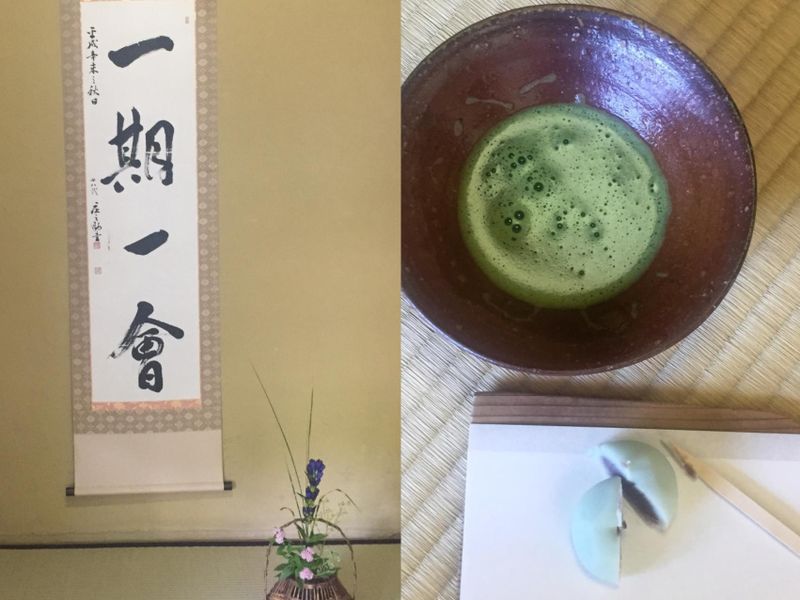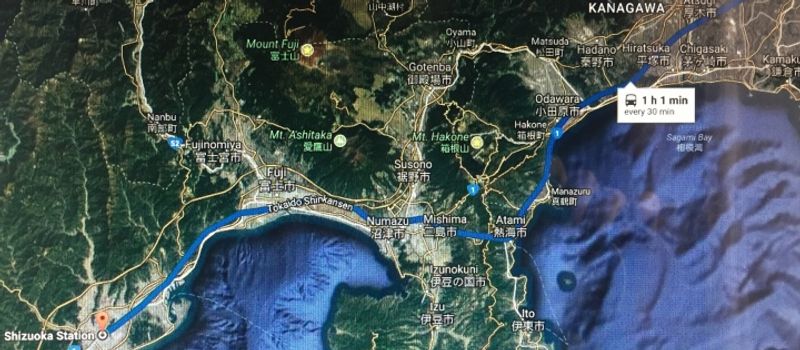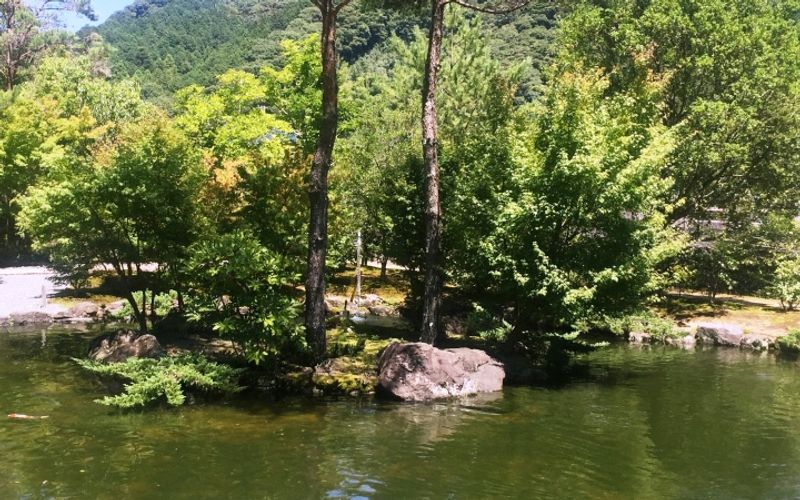Aug 19, 2017
一期一会 and The Way of Tea
一期一会, ichi-go-ichi-e, is a Japanese proverb that translates literally to “one-time-one-meeting”, but the depth of its true meaning is lost if you only use this simple, literal translation. Its true essence is the Japanese cultural practice of treasuring each encounter with other people. It is often translated as “a once in a lifetime meeting” which might lead you to think of an opportunity to meet some famous individual, but, in fact, every meeting and interaction with another is unique, and therefore, “once in a lifetime”. The proverb originated in the practice of the Japanese tea ceremony, or the way of tea, as it is perhaps more accurately called, with the intent that sincerity should be practiced mutually by both host and customers. Over time the practice seeped into everyday living and culture, which is to say, into the Japanese way of thinking. This might not be so obvious but if you look at its essence you may see it expressed as “striving to perfect what you love”, or “leave nothing to chance”, or, maybe most obvious in Japan, “respect for others”.

The scene is set as the Shinkansen (“bullet train”) bullets its way out of Tokyo station, through Kanagawa, and on to Shizuoka, with blue skies as far as the eye can see, Mount Fuji looming majestically in the distance in its everyday magnificence. I didn’t embark on my day thinking “today, I will practice ichi-go-ichi-e”, but I know the principle of this proverb was practiced on me. On arriving at Shizuoka station a bus is waiting for us, and we drive through green, luscious countryside, rows and rows of neatly-lined, deep-green tea plants speckle the land from the road side up into, and over the rolling hills. This is Japan’s tea country; Shizuoka. Shizuoka produces 40% of Japan’s green tea, and green tea from here is also exported all over the world. The locals here are proud of Shizuoka tea, perhaps even passionate.

We arrive at Gyokuro-no-Sato, a roadside park bordered by the Asahina river. The facilities here include a restaurant, shops, a small tea plantation, and the tea-house where we will participate in the Japanese tea ceremony. As we enter the grounds of the tea-house we are submerged in nature, the gardens are enclosed by green hills, our ears assaulted by the midsummer song of hundreds, perhaps thousands, of cicadas. The sun is reflecting off the many-colored carp, and the sound of the water flowing into the pond makes me feel a little cooler. Our shoes crunch on the gravel as we wander off the path, then steppingstones lead us to the door of the tea-house.

In the tea-room, two walls have shoji (“paper sliding doors”) with the bottom half open, revealing the pond and the lower half of the hills. I absorb it all and my body relaxes without prompting. Then I notice the scroll with ichi-go-ichi-e brushed on its fabric, hanging in the toko-no-ma (“an alcove where art and flowers are displayed”), reminding us, that here, in this tea-house, as in many tea-houses across Japan, that ichi-go-ichi-e is an integral part of the way of tea, even if it is not an integral part of how we live.
The name of this tea-house is Hyogetsu-tei which has three kanji, 瓢 - 月 - 亭, “gourd-moon-tea-house”, and so, there are gourd carvings on the walls, and incorporated into the design of the shoji is the moon, as it rises above the mountain in the background. Unnoticed at first but once explained the imagination is fired. Even the details of the door handles show the different stages of the moon and each moon is encompassed by gourds. This kind of detail accentuates the idea that this is perhaps a once in a lifetime experience. “Detail”, Japan's middle name is sometimes a frustrating inconvenience for us non-Japanese as we maneuver our way through government documents and life, but in a Japanese tea-house, such details must be treasured.
 We take our seats, and the host joins us. She is personable, respectful, attentive, and eager to share her expertise, and her knowledge of this classical Japanese art. She is unencumbered by her kimono, rising and returning to her seiza (“formal/correct way of sitting”), easily and smoothly. She shows us how to mix the tea, whisking the powdered green tea, blending it with the water. We each receive a bowl of usucha (“light tea”). The tea is of course important, which type of tea, its origin, the way it is mixed, the temperature, and volume of water used, no detail left to chance, but, in many ways it is only a symbol. A symbol and conduit to bring us together, an opportunity to meet, and to create, a moment filled with appreciation of life and the beauty therein. Like, how and when to turn your tea-bowl so that the ornate side faces your guest as you drink, and once you finish drinking, you must inspect the bowl, admire it from all sides, because in any tea-house worth its tea, each tea bowl is unique, and so, in order to show appreciation to your host, or the maker of the bowl, or just for the beauty of the way of tea, you inspect the bowl. A wagashi (“a traditional Japanese sweet”) is served. We are encouraged to taste the tea before tasting the wagashi, and again, after tasting the wagashi. The contrast of the sweet and the slightly bitter tea awakening the taste buds. All my senses are engaged now.
We take our seats, and the host joins us. She is personable, respectful, attentive, and eager to share her expertise, and her knowledge of this classical Japanese art. She is unencumbered by her kimono, rising and returning to her seiza (“formal/correct way of sitting”), easily and smoothly. She shows us how to mix the tea, whisking the powdered green tea, blending it with the water. We each receive a bowl of usucha (“light tea”). The tea is of course important, which type of tea, its origin, the way it is mixed, the temperature, and volume of water used, no detail left to chance, but, in many ways it is only a symbol. A symbol and conduit to bring us together, an opportunity to meet, and to create, a moment filled with appreciation of life and the beauty therein. Like, how and when to turn your tea-bowl so that the ornate side faces your guest as you drink, and once you finish drinking, you must inspect the bowl, admire it from all sides, because in any tea-house worth its tea, each tea bowl is unique, and so, in order to show appreciation to your host, or the maker of the bowl, or just for the beauty of the way of tea, you inspect the bowl. A wagashi (“a traditional Japanese sweet”) is served. We are encouraged to taste the tea before tasting the wagashi, and again, after tasting the wagashi. The contrast of the sweet and the slightly bitter tea awakening the taste buds. All my senses are engaged now.

If you are presented with an opportunity to participate in a Japanese tea ceremony, then go. Go with an open mind, willing to have a new experience. Forget about how many refills are included (none), forget about the size of the sweets (small), let all you know and believe behind you, let your ideas on what you might experience fly out the window of the Shinkansen as you race to Shizuoka, let them go and come to this place with a clean soul and spirit, and allow yourself to have a new experience, ichi-go-ichi-e.
Thanks to City Cost (Shizuoka Green Tea) for the opportunity to visit Gyokuro-no-Sato, and thanks to The World Green Tea Association for their hospitality and generosity.
The following links provide some more detailed information:
Basic Information for Gyokuro-no-Sato (玉露の里)
Basic information for Hyogetsu Teahouse
Fujieda City information for Gyokuro-no-Sato (玉露の里)
Facebook page for Gyokuro-no-Sato (玉露の里)
This post is a special tea blog report, part of our Shizuoka Green Tea Guide, and a chance through City-Cost for bloggers in Japan to engage in new “Japan” experiences about which to create posts.
Helping other non-Japanese stay positive in this sometimes-tough-to-survive-in but amazing country.



4 Comments
BigfamJapan
on Aug 19
Incredibly evoking piece, you brought me right back to the tea house and really portray the magnificence of the time we spent there. I love all the detail about the tea house, it really is a fascinating and stunning place.
LovingJapan
on Aug 19
@Saitama Thanks for reading and commenting. I look forward to experiencing more of what's beautiful in Japan with you in the future.
Hiroshi9070
on Sep 18
I love Ichi-go-ichi-e.
LovingJapan
on Sep 19
@Hiroshi9070 Thanks Hiroshi - me too!